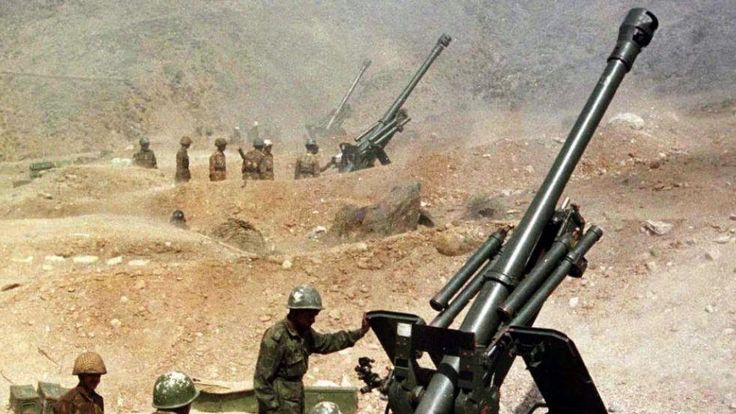Reading Time: 6 minutes
India and Pakistan were on the brink of a war. The tensions in the western borders of the two countries continue to be tense. Tapati shows us the many faces of war, in her erudite analysis, in three parts. Here’s part one. A Special Feature, exclusively for Different Truths.
Once the chills of January left, we had a sigh of relief though some parts of the world were still rolling in snow. People in Kolkata started packing up their woolens singing tunes of spring, the weather was changing and suddenly whole of India was heated up. The love of Valentine’s Day was in air but on the same day, a  convoy of vehicles carrying security men on Jammu and Kashmir National Highway was attacked by a vehicle-borne suicide attacker in Pulwama district. The attack resulted in the deaths of 40 Central Reserve Police Force (CRPF) personnel. Indian blood was boiling after the carnage at Pulwama by terrorists. In every corner, the topic of discussion was that sons of soil were killed by terrorists from Pakistan; Pakistan-based militants in Kashmir have increasingly taken to high-profile attacks against the Indians; this has been a vexed problem for long, a hard test of patience; but what is coming next? No one in India was ready to tolerate these attacks and loss of blood anymore.
convoy of vehicles carrying security men on Jammu and Kashmir National Highway was attacked by a vehicle-borne suicide attacker in Pulwama district. The attack resulted in the deaths of 40 Central Reserve Police Force (CRPF) personnel. Indian blood was boiling after the carnage at Pulwama by terrorists. In every corner, the topic of discussion was that sons of soil were killed by terrorists from Pakistan; Pakistan-based militants in Kashmir have increasingly taken to high-profile attacks against the Indians; this has been a vexed problem for long, a hard test of patience; but what is coming next? No one in India was ready to tolerate these attacks and loss of blood anymore.
In our new complex, I happened to join a group of people in an informal meeting and the analysis and comments on various topics over cups of tea in the mid-morning. They were from a cross-section of people of varied ages and professions with one common link that all were retired and had ample time to exercise tongues and stir their brain.
On 15th morning as I joined them at them at Tea-Junction, one gentleman was especially noticed, not by his unshaven face and ruffled hair but a loud voice with occasional throwing hands in the air. I was a new-comer hence pulled my chair to a safe corner before asking my friend who the gentleman was. “Dr. Chatterji, retired professor of Political Science from Delhi, recently moved in our complex…”, was the muffled answer from my friend.
“Hello, please give me your hearing… let me enlighten you my friends on the warfare and polity of the past and present.” Loud request roared to mute my faint queries. People looked up with big eyes since this has been a hot topic of discussion over the last few days.
“…our technologies and experiences may be very different from the past, human nature, politics and state behaviour do not appear to have changed quite as much.”
“There exist continuities between the ancient and the modern periods that make trans-historical comparisons a worthwhile pursuit. While our technologies and experiences may be very different from the past, human nature, politics and state behaviour do not appear to have changed quite as much.” Professor’s thunderous voice continued…
“An analysis of old Indian ideas of the necessity and justification for the use of force, on politics and international relations is still useful because in many ways the world which we face today, challenges of multiple states and of several major powers remain similar. I hope you all know who Kautilya was…. The greatest master of polity, thousands of years ago.
Henry Kissinger in his book, World Order, refers to the ancient Indian treatise, the Arthashastra, as a work which depicts the “dominant reality” in politics. For Kissinger, the Arthashastra contained a realist vision of politics long before The Prince, by Machiavelli. These are renowned books on polity, but we should not forget how the strategic significance of the Arthashastra, Shukraniti, and other scriptures. They are closely connected to the return of history in explaining state behaviour.
Henry Kissinger in his book, World Order, refers to the ancient Indian treatise, the Arthashastra, as a work which depicts the “dominant reality” in politics.
Indian thinkers from historical times produced two schools of war, the dharmayuddha (ethical warfare) school; and the kutayuddha (devious warfare) school.
Kautilya narrated five kinds of war:
(a) Prakashayuddha (Open War): This war is openly waged and is fought on the lines of dharmayuddha. It is fought with rules and within a lawful framework and is a conventional war in modern lexicon. Wars between two nations like India-Pakistan wars of 1965, 1971 and the World Wars fall in this category.
(b) Kutayuddha (Deceptive War): The concealed war refers to irregular warfare and psychological warfare. It is an unrighteous and deceitful war fought with no restrictions and in which time-honoured principles are sacrificed at the altar of expediency. It permits the use of deadly and  poisonous weapons which can cause mass destruction and slay thousands of persons. The objective is paramount, and no means are restricted from achieving it whether legal or illegal. A modern-day example of this kind of warfare would be the terrorist groups which wage war against states and do not hesitate to murder innocents to further their agenda.
poisonous weapons which can cause mass destruction and slay thousands of persons. The objective is paramount, and no means are restricted from achieving it whether legal or illegal. A modern-day example of this kind of warfare would be the terrorist groups which wage war against states and do not hesitate to murder innocents to further their agenda.
(c) Tusniyuddha (Silent War): In this war, the enemy is struck silently in order to not draw public attention to the doer. However, the objective is always paramount. Cyber Warfare is a form of this war.
(d) Mantrayuddha (Diplomatic War): A war by counsel, describing the exercise of diplomacy employed by a king when he considers it unwise to wage war; this involves a battle of intrigue and also by giving wrongful counsel. It involves spreading rumors, falsehood, applying threats of public shame and loss of face which compel the state leadership to toe the line dictated. It does not involve the loss of human life or capital. It is followed when the state wishes to avoid war and uses soft power to deny the adversary the advantage or the opportunity to wage war against it. Examples of this war include the use of international institutions like IMF / World Bank / NPT to apply pressure on a nation and use of United Nations (UN) sanctions to force a country to toe the international opinion.
(e) Gudhayuddha (Secret War): A clandestine war, using covert methods to achieve the objective without actually waging a battle. It employs covert violence to confound and subvert the enemy, while assassinating the enemy’s leadership and important infrastructure. This Secret War was a variation of kutayuddha. It involved employing irregulars to wage war against a nation, while outwardly the state is enjoying regular diplomatic ties. In waging clandestine war, the king used not only his own agents and double agents, but also allies, vassal kings, tribal chiefs and the suborned friends and supporters of the enemy. It is akin to cold war norms or proxy war where covert violence, assassination and other means were employed to weaken the enemy.”
People were already high with patriotic mood and applauded his impressive talk. He continued, “Remember that in the Indian scriptures, the power to wage war was released from the logic of dharma and the duties expected of the virtuous king; the goal was the happiness of the state, not anybody’s personal gain.
“In the Indian scriptures, the power to wage war was released from the logic of dharma and the duties expected of the virtuous king; the goal was the happiness of the state, not anybody’s personal gain.”
“Since wars are always devastating various factors were to be considered before the ruler decides whether it is in the state’s interest to commence the campaign. These included Relative strengths of power, place and time, Seasons for marching on a campaign, Employment of troops, Calculation of losses, expenses. Assessment of dangers and methods of overcoming of dangers were calculated. Maybe same factors are applicable even today and policies are finalised in confidential meetings of powerheads.”
People were till now silent listeners; now they started whispering, “Does the present situation call for a war against the land of terrorism?”
“My friends, in the past and as well as on today, before taking a step towards war, a ruler should consider the place and time, the strength and means, affection and disaffection caused by it, its nearness and distance, its present and future effects, its constant worth or worthlessness.”
Highlighting the importance of time and place, it was stated that, “In the daytime, the crow kills the owl. At night, the owl kills the crow.” Thus, the time of fight is important. Similarly, “A dog on land, drags a crocodile; and a crocodile in water, drags a dog,” is meant to emphasise that the place of a fight is important.
“In daytime, the crow kills the owl. At night, the owl kills the crow.” Thus, the time of fight is important.
 Maybe our days are spent in worries; even weeks may go; but let us have our courage high and remain positive.”
Maybe our days are spent in worries; even weeks may go; but let us have our courage high and remain positive.”
By the time he ended his speech and had time to look through his bifocals, our group of friends got busy in hurrying their last sip of tea, content with our past wisdom.
People got into a noisy heavy discussion, arguing over probable steps to be followed. Through TV and social media channels, all are well equipped with details of what is happening every moment.
“India has age old wisdom and intellectuals since thousands of years back! We want to know more on similar topics. Thanks professor.” An appeal followed from the audience and the professor was ready with abroad smile, “Sure, we will meet in next session over tea…”
(To be continued)
©Tapati Sinha
Photos from the Internet

















Interesting information on types of war …weaved well into this article.Enjoyed reading it.
Kiren
Very useful discussion.
War must bring happiness to the state.
Not the gain of an individual. The message goes home. Congratulations
Excellent write. Educative as well as inspirational.
Tapati-I felt like I was at Tea-Junction sipping tea , wide eyed listening to this informed knowledgeable professor- relearning past and present views on warfare. Cannot wait for more on this topic from you, part 2 and 3. We have come a long way from the days of virtuous kings mission and goals for a war but prajas concerns; pains; losses stay the same.
Beautifully penned and apt!
We reiterate in unison, no matter what, let us have our courage high and stand positive!